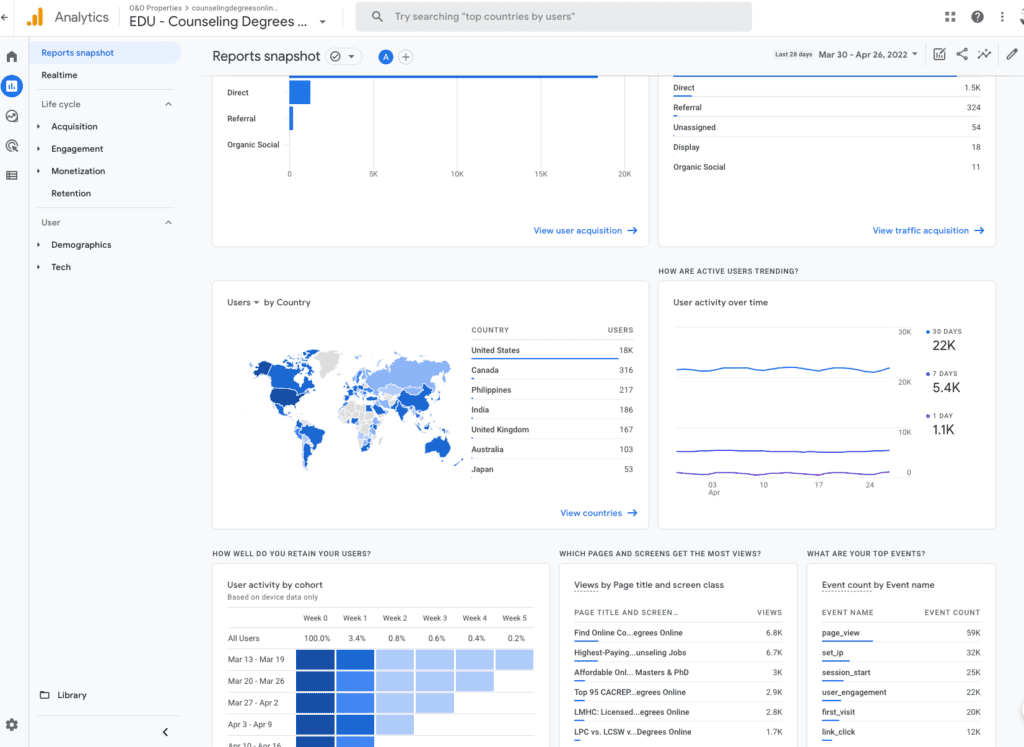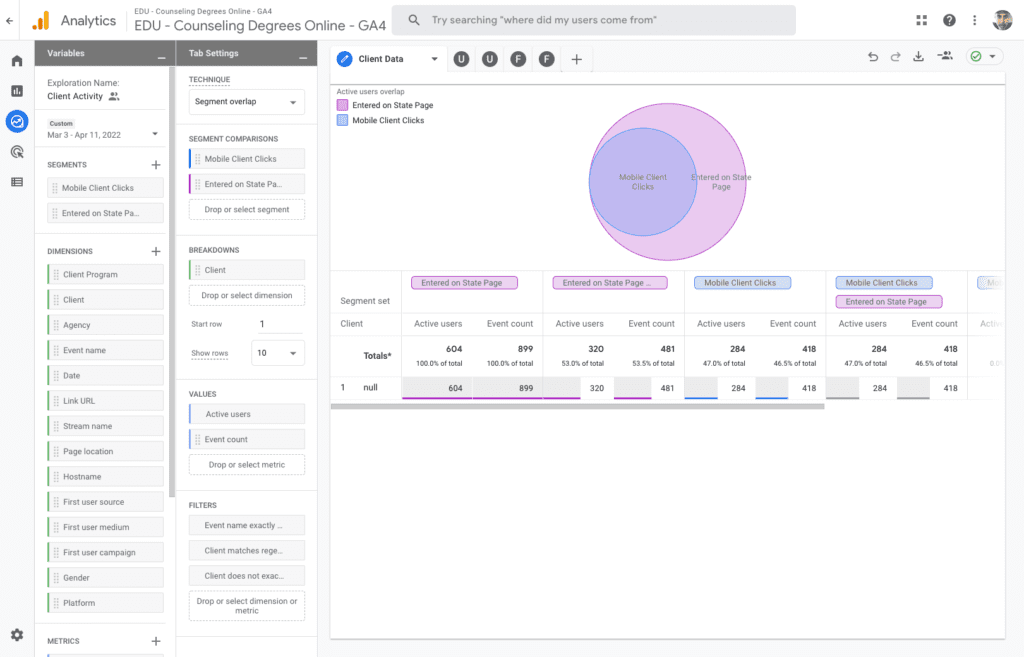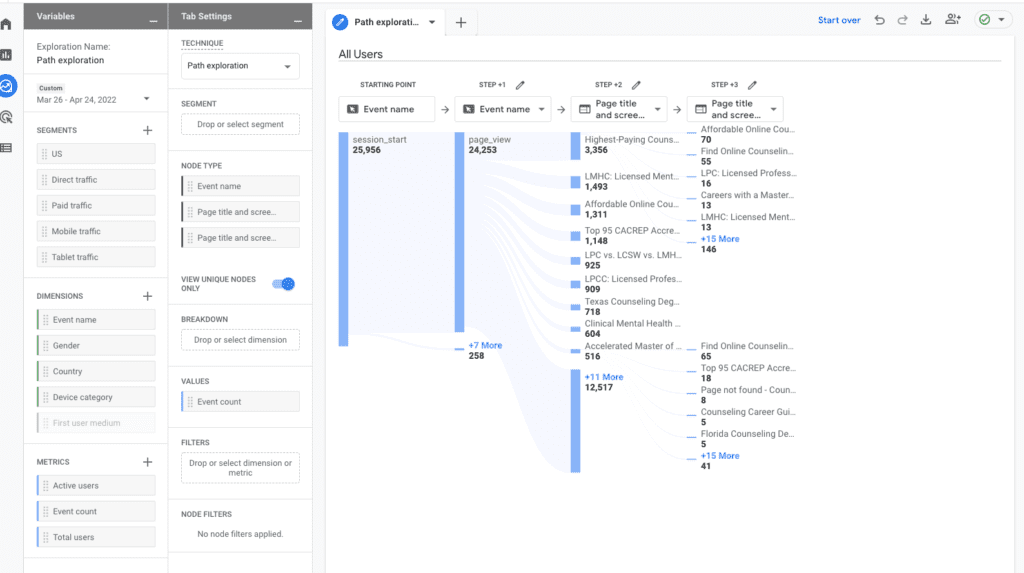What Is Google Analytics 4, and How Does It Impact Higher Ed?
This article is the first in a series covering higher education analytics trends.
It’s called upgrade fatigue. Just when your digital marketing team has mastered the intricacies of a new platform and configured it to your school’s exact specifications, another update comes along, and they have to begin all over again. Keeping up with updates is hard, but it’s worth it.
That’s certainly the case with the latest version of Google Analytics, known as Google Analytics 4 (GA4 for short). Launched in October 2020 — while higher ed was preoccupied with navigating the pandemic — GA4 has new and exciting features that provide valuable data for optimizing your school’s website and honing your marketing strategy.
But there’s a catch: Reaping GA4’s benefits will require marketers to build, configure, and install a new platform. GA4 is no mere product upgrade but almost an entirely new product that’s due to fully replace its predecessor on July 1, 2023, when the current version, Universal Analytics, will be sunset.
Don’t panic! To help colleges and universities — especially those with smaller marketing teams — migrate to GA4, we’ve asked Archer Education’s senior director of web analytics, John Oren, for insight on GA4 and advice on making the switch.
What Is Google Analytics?
Google Analytics is an indispensable tool used by many colleges and universities — along with numerous other companies and organizations — to analyze their website traffic and optimize their digital presence.
The current version, which you’re likely using now, is known as Universal Analytics (UA). Like a digital crystal ball, UA reveals who is visiting your institution’s website, how visitors are interacting with individual pages, the specific information they’re seeking, and, most importantly, whether they’re tapping “Click to Apply.” It’s safe to say that many higher-ed marketers can’t envision the future without it.
Fortunately, your marketing team won’t have to. But to get the most from Google’s latest release, marketers will need to understand GA4’s new features and potential and go boldly into the future.
What Makes GA4 Different?
The differences between UA and GA4 are many, John explains, noting that GA4 has several advantages over its predecessor. We’ll focus on two of the major changes coming your way.
GA4 Works on an Event-Driven Model
Soon-to-be-retired Universal Analytics and its successor GA4 are based on entirely different models: GA4 works on an event-driven model, while UA uses the measurement model based on sessions and pageviews. GA4 defines an event as a user’s interaction/activity with a webpage element such as video, request for information, or click-to-enroll button.
With UA, every event needed to be configured separately using either the global site tag or Google Tag Manager. However, with GA4, every tracked activity by a prospective student on your website is considered an event that can provide detailed information. The good news is that GA4 events come preconfigured, so no additional coding or tagging is required, according to Optimize Smart.
“On this release, a lot has changed, and there are both upsides and downsides to this,” John says. “Previously, Google Analytics was used overwhelmingly on websites. It was really designed with that purpose in mind, with metrics like page views and conversion rate. With GA4, the platform is designed with more flexibility in mind and is intended to be used with mobile apps, video games, social media platforms, and point-of-sale devices, to name a few. As a result, it needs to be conceptualized, planned, and configured much more than the previous versions of Google Analytics.”
GA4 Features a New Reporting Interface
When viewing the new GA4 interface, don’t expect to see the same reports and metrics available in UA. They’ve been either removed or replaced.
The new interface offers a layout based on “cards,” which can be customized by the user. It also has a drag-and-drop feature, much beloved by Google users. “I suspect this is where many people will go to review their latest numbers,” John states. “This feature was previously only available in the notoriously expensive paid version called BigQuery.” The interface offers a bonus upgrade from GA360 in that it now includes columns.
Here’s a quick view of what the cards layout looks like:

And here are a couple of snapshots of the Explore feature:


GA4 users can expect to see different sets of reports and fewer of them. That’s because many of the reports are only generated once you begin tracking them. Notable absences include bounce and conversion rates.
“I think this might be the thing that surprises most people…especially the lack of conversion rate data.” John says. “[In the higher-ed industry] we often hang our hats proudly on the practice of using well-defined goals and the funnel or conversion rate of acquiring goals.” GA4 will eventually add conversion rate, but users currently must go to another platform, such as Google Sheets or Google Data Studio, to gather this information.
Bounce rate has been replaced by engagement rate, which is essentially the opposite of bounce rate. “Engagement rate is a more optimistic spin on the bounce rate metric,” John explains. Additionally, at this point, users can’t use calculated metrics to create their own version of a conversion rate.
While the changes may take a while to get used to, GA4 should ultimately make the task of digital analytics management easier for higher-ed professionals. Other GA4 changes and enhancements include:
- GA4 is more feature-rich, with expanded parameters.
- GA4 offers expanded, advanced AI insights.
- GA4 will integrate with BigQuery, saving significant investment costs.
- GA4 offers greater integration and cross-device reporting.
- GA4’s Explore function allows deep, flexible pivot-like reporting.
- GA4 allows Google to track how a prospective student actually interacts with your website, providing more customer-centric insights.
What Are GA4’s Implications for Higher Ed?
In addition to helping universities better understand their site-traffic data and optimize student engagement opportunities, GA4 also has implications for university data privacy procedures. “One of the unique attributes of universities is their mission to protect students’ personally identifiable information,” according to John.
Under the General Data Protection Regulation (GDPR) adopted by the European Union in 2018 — and essentially in effect in the United States — higher-ed institutions are tasked with protecting the personally identifiable information captured and stored on school websites. Google Analytics has come under fire and been the target of lawsuits in Europe for its use of cookies as a breach of privacy under GDPR.
Fortunately, unlike its predecessors, privacy-focused GA4 will support the current UA cookie and is equipped to also support cookieless tracking through modeling and AI. These changes will allow higher-ed digital marketers to track student activity on websites throughout their student journey.
Enhance Your Analytics Insights and Boost Engagement Now
Google has stopped new development on UA, which it plans to discontinue in July 2023 — meaning website managers will want to migrate to GA4 as soon as possible. Whether your institution is currently working on the GA4 transition or has yet to start the process, it’s important to familiarize yourself with what’s changing in the latest iteration.
Here at Archer Education, we partner with accredited universities to help higher-ed leaders and marketers accelerate online learning growth and enrollment. We believe that education is the great equalizer in our society, and we strive to help institutions make education more accessible for all adult learners.
We offer a variety of tech-enabled marketing, enrollment, and retention services, and our website development team helps higher-ed institutions design, build, and optimize websites that make an impact on student engagement. If you’d like to learn more, contact our team and explore our offerings today.



